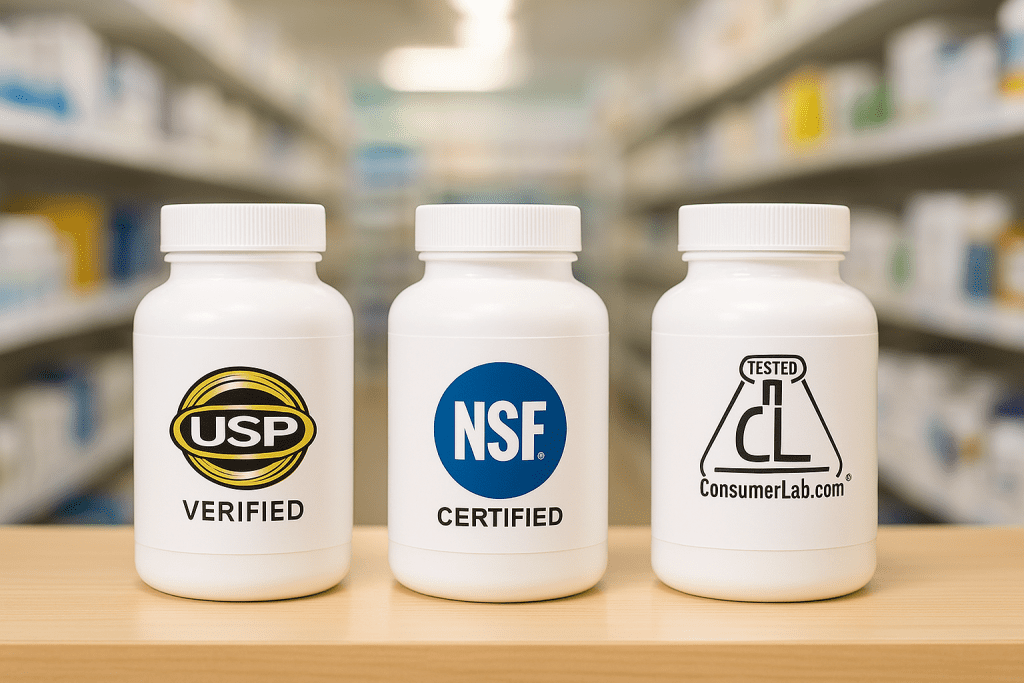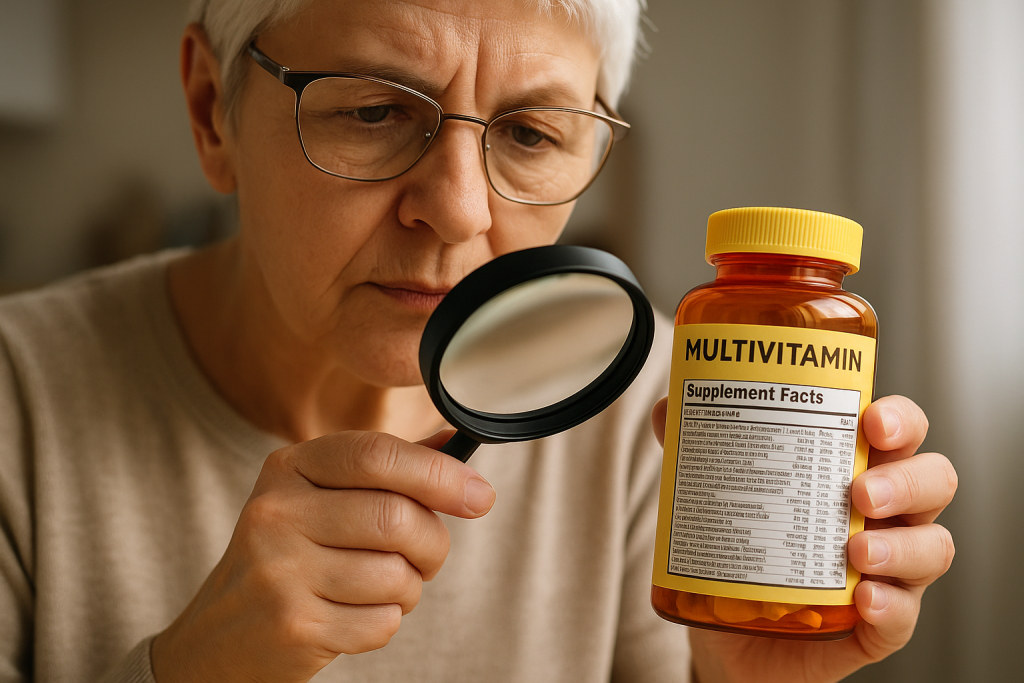Even a daily multivitamin can pose risks when managing multiple prescriptions. Patients seeking a safe multivitamin for polypharmacy should focus on certified products with low interaction potential.
This article highlights trusted, third-party verified multis designed to reduce medication conflicts, especially for seniors and those taking five or more medications.
We’ll explore certifications like USP and NSF, list certified multivitamins with minimal risk, and share expert-backed tips on selecting supplements for polypharmacy patients.
Summary / Quick Answer
Looking for a certified drug interaction-free multi? Here’s what to prioritize:
- Look for third-party certifications: USP Verified, NSF Certified, or ConsumerLab Approved
- Avoid megadoses of vitamins A, E, or K if you’re on anticoagulants or liver-sensitive meds
- Choose clean-label products with no hidden herbs or stimulants
- Space mineral-rich multis away from antibiotics or thyroid meds
- Talk to a pharmacist if you take 5+ medications
| Multivitamin | Certifications | Ideal For |
|---|---|---|
| Nature Made Multi with Iron | USP Verified | Affordable, broad coverage |
| Garden of Life mykind Organic Women’s | NSF + USDA Organic | Plant-based, whole-food blend |
| Thorne Multi-Vitamin Elite AM/PM | NSF for Sport | Active adults, split dosing |
| Kirkland Signature Daily Multi | USP + ConsumerLab | Seniors seeking trusted basics |
Why Certification Matters When Taking Multiple Meds
When you’re taking several medications, choosing a multivitamin becomes more than just a nutritional decision—it’s about safety. Certification seals from third-party organizations act as a crucial safety net.

Understanding the Role of Certification
- USP Verified means the supplement meets rigid standards for purity, potency, and ingredient accuracy. Products with this mark are less likely to include unlisted compounds that could interact with medications (USP).
- NSF Certified products are tested not only for ingredient content but also for contaminants and banned substances. The NSF Certified for Sport line goes a step further, screening against over 270 drugs (NSF).
- ConsumerLab Approval offers another layer of transparency, with batch-tested reports verifying disintegration, dosage, and absence of harmful contaminants (ConsumerLab).
These certifications help reduce the risk of unintended interactions or inconsistent dosing.
Visual: What Each Seal Guarantees
| Seal | What It Verifies |
| USP Verified | Identity, potency, purity, manufacturing |
| NSF Certified | Label claims, contaminants, banned drugs |
| ConsumerLab Approved | Disintegration, purity, ingredient match |
Common Multivitamin Risks in Polypharmacy
Certain vitamins and minerals can directly interact with medications, making product choice critical.

Key Interaction Risks to Watch For
- Vitamin K + Warfarin: Vitamin K affects blood clotting. Inconsistent intake can throw off INR levels.
- Calcium/Magnesium + Antibiotics: These minerals bind to some antibiotics (like tetracyclines), reducing absorption.
- Iron + Thyroid Medications: Iron can impair the absorption of levothyroxine.
- Vitamin A/E + Blood Thinners: High doses may raise bleeding risk.
Scheduling supplements separately or selecting a formula with adjusted doses can mitigate these risks. For example, splitting dosing – like in Thorne’s AM/PM formula – helps avoid peak interactions.
To further reduce interaction risks, some users rely on tools like this app comparing supplement brands for purity.
Table: Supplement + Drug Red Flags
| Nutrient | Drug Class It Affects | Guidance |
| Vitamin K | Anticoagulants (e.g. warfarin) | Keep intake consistent or choose low-K |
| Calcium | Antibiotics, thyroid meds | Dose 2–4 hours apart |
| Iron | Thyroid hormone | Separate dosing or use iron-free formula |
| Vitamin A/E | Blood thinners | Avoid megadoses |
How to Choose a Multivitamin If You Take Multiple Medications
Choosing the right multivitamin isn’t just about what’s in it, but what’s not. For seniors and adults managing chronic conditions, a few straightforward steps can help minimize interaction risks.

1. Stick With Certified Brands
Go for multivitamins with visible USP, NSF, or ConsumerLab logos. These labels ensure accuracy and safety, as shown in this visual reference.
2. Check for Red Flag Ingredients
Scan the label for excessive vitamin A (over 5,000 IU), vitamin E (over 150 IU), or vitamin K. These fat-soluble vitamins can linger in the body and influence drug metabolism.
3. Time It Right
Take your multivitamin at least 2 hours before or after any medications known to interact with minerals or fat-soluble nutrients.
4. Prioritize Simplicity
The fewer the ingredients, the easier it is to track potential interactions. Some multis include herbal extracts like ginseng or green tea that may not be well studied in drug users. These extras can be a hidden issue.
5. Ask a Pharmacist
Especially for those on five or more prescriptions, a pharmacist-led review can help eliminate redundancies or find safer alternatives. As polypharmacy grows more common, these reviews are becoming standard practice (source).
Related: Vitamin D3 interaction with statins muscle pain
Recommended Certified Multivitamins for Polypharmacy Patients
Here’s a closer look at some top-rated multivitamins that meet certification and interaction safety standards.
| Brand/Product | Certifications | Notes |
| Nature Made Multi with Iron | USP Verified | Reliable, broad-spectrum coverage; iron included |
| Nature Made Women’s Multi | USP Verified | Balanced with iron + folic acid for women |
| Kirkland Signature Daily Multi | USP + ConsumerLab | Budget-friendly, well-rounded |
| Thorne Elite AM/PM | NSF Certified for Sport® | Advanced, separate AM/PM dosing |
| Garden of Life mykind Organics | NSF + USDA Organic | Clean-label, food-based ingredients |
Each of these options avoids megadoses and includes a trusted verification seal. Many are also featured on ConsumerLab’s 2024 top-rated list.
Conclusion
Choosing a safe multivitamin for polypharmacy doesn’t have to be complicated. The key is focusing on third-party certifications, avoiding ingredients that are known to interact with medications, and talking to a healthcare provider when unsure.
For older adults or those managing complex regimens, a pharmacist-led review can fine-tune supplement timing and content. Always double-check for interactions when starting a new multivitamin, especially if you’re already using multiple prescriptions.
Explore more tools and resources like our app comparing supplement brands for purity or learn about Vitamin D3 interaction with statins and muscle pain to take the next step toward safer supplementation.

